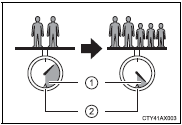Toyota Corolla (E170) 2014–2019 Owners Manual / Driving / Before driving / Cargo and luggage / Calculation formula for your vehicle
Toyota Corolla (E170): Calculation formula for your vehicle
1 Cargo capacity
2 Total load capacity (vehicle capacity weight)

When 2 people with the combined weight of A lb. (kg) are riding in your vehicle, which has a total load capacity (vehicle capacity weight) of B lb. (kg), the available amount of cargo and luggage load capacity will be C lb. (kg) as follows:
B*2 lb. (kg) - A*1 lb. (kg) = C*3 lb. (kg)
*1: A =Weight of people *2: B =Total load capacity *3: C =Available cargo and luggage load
In this condition, if 3 more passengers with the combined weight of D lb. (kg) get on, the available cargo and luggage load will be reduced E lb. (kg) as follows:
C lb. (kg) - D*4 lb. (kg) = E*5 lb. (kg)
*4: D =Additional weight of people *5: E =Available cargo and luggage load
As shown in the example above, if the number of occupants increases, the cargo and luggage load will be reduced by an amount that equals the increased weight due to the additional occupants. In other words, if an increase in the number of occupants causes an excess of the total load capacity (combined weight of occupants plus cargo and luggage load), you must reduce the cargo and luggage on your vehicle.
CAUTION
■Things that must not be carried in the trunk
The following things may cause a fire if loaded in the trunk:
●Receptacles containing gasoline ●Aerosol cans
■Storage precautions
Observe the following precautions.
Failure to do so may prevent the pedals from being depressed properly, may block the driver’s vision, or may result in items hitting the driver or passengers, possibly causing an accident.
●Stow cargo and luggage in the trunk whenever possible.
●To prevent cargo and luggage from sliding forward during braking, do not stack anything in the enlarged trunk. Keep cargo and luggage low, as close to the floor as possible.
●Do not place cargo or luggage in or on the following locations.
• At the feet of the driver
• On the front passenger or rear seats (when stacking items)
• On the package tray
• On the instrument panel
• On the dashboard
• Tray that has no lid
●Secure all items in the occupant compartment.
●When you fold down the rear seats, long items should not be placed directly behind the front seats.
●Never allow anyone to ride in the enlarged trunk. It is not designed for passengers. They should ride in their seats with their seat belts properly fastened.
■Capacity and distribution
●Do not exceed the maximum axle weight rating or the total vehicle weight rating.
●Even if the total load of occupant's weight and the cargo load is less than the total load capacity, do not apply the load unevenly. Improper loading may cause deterioration of steering or braking control which may cause death or serious injury.
Other materials:
Rear wheel alignment
Inspection
1. Inspect tire
2. Measure vehicle height
Notice:
before inspecting the wheel alignment, adjust the vehicle height to the
specified value.
3. Inspect toe–in
Toe–in:
usa, canada:
Mexico:
If the toe–in is not within the specified value, inspect and replace
the susp ...
Maintenance data (fuel, oil level,
etc.)
Dimensions and weight
*1:Unladen vehicles
*2:Vehicles without 18-inch tires
*3:Vehicles with 18-inch tires for Guam and Saipan
*4:Vehicles with 18-inch tires except for Guam and Saipan
*5:For Guam and Saipan
Seating capacity
Vehicle identification
■ Vehicle identification number
The vehicle iden ...
Blind Spot Monitor operation
■ Objects that can be detected while driving
The Blind Spot Monitor uses rear side radar sensors to detect the following
vehicles traveling in adjacent lanes and advises the driver of
the presence of such vehicles via the indicators on the outside rear
view mirrors.
Vehicles that are traveling ...


